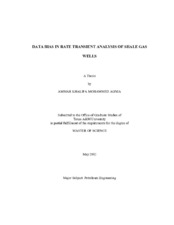| dc.contributor.advisor | Maggard, Bryan | |
| dc.contributor.advisor | A. Wattenbarger, Robert | |
| dc.creator | Agnia, Ammar Khalifa Mohammed | |
| dc.date.accessioned | 2012-07-16T15:57:54Z | |
| dc.date.accessioned | 2012-07-16T20:23:29Z | |
| dc.date.available | 2012-07-16T15:57:54Z | |
| dc.date.available | 2012-07-16T20:23:29Z | |
| dc.date.created | 2012-05 | |
| dc.date.issued | 2012-07-16 | |
| dc.date.submitted | May 2012 | |
| dc.identifier.uri | https://hdl.handle.net/1969.1/ETD-TAMU-2012-05-10853 | |
| dc.description.abstract | Superposition time functions offer one of the effective ways of handling variable-rate data. However, they can also be biased and misleading the engineer to the wrong diagnosis and eventually to the wrong analysis. Since the superposition time functions involve rate as essential constituent, the superposition time is affected greatly with rate issues. Production data of shale gas wells are usually subjected to operating issues that yield noise and outliers. Whenever the rate data is noisy or contains outliers, it will be hard to distinguish their effects from common regime if the superposition time functions are used as plotting time function on log-log plots. Such deceiving presence of these flow regimes will define erroneous well and reservoir parameters. Based on these results and with the upsurge of energy needs there might be some costly decisions will be taken such as refracting or re-stimulating the well especially in tight formations.
In this work, a simple technique is presented in order to rapidly check whether there is data bias on the superposition-time specialized plots or not. The technique is based on evaluating the kernel of the superposition time function of each flow regime for the maximum production time. Whatever beyond the Kernel-Equivalent Maximum Production Time (KEMPT) it is considered as biased data. The hypothesis of this technique is that there is no way to see in the reservoir more than what has been seen. A workflow involving different diagnostic and filtering techniques has been proposed to verify proposed notion. Different synthetic and field examples were used in this study.
Once the all problematic issues have been detected and filtered out, it was clear that whatever went beyond the KEMPT is a consequence of these issues. Thus, the proposed KEMPT technique can be relied on in order to detect and filter out the biased data points on superposition-time log-log plots. Both raw and filtered data were analyzed using type-curve matching of linear flow type-curves for calculating the original gas in-place (OGIP). It has been found that biased data yield noticeable reduced OGIP. Such reduction is attributed to the early fictitious onset of boundary dominated flow, where early false detection of the drainage boundaries defines less gas in-place occupied in these boundaries. | en |
| dc.format.mimetype | application/pdf | |
| dc.language.iso | en_US | |
| dc.subject | Superposition time functions | en |
| dc.subject | Data Bias in Rate Transient Analysis | en |
| dc.subject | material balance time | en |
| dc.title | Data Bias in Rate Transient Analysis of Shale Gas Wells | en |
| dc.type | Thesis | en |
| thesis.degree.department | Petroleum Engineering | en |
| thesis.degree.discipline | Petroleum Engineering | en |
| thesis.degree.grantor | Texas A&M University | en |
| thesis.degree.name | Master of Science | en |
| thesis.degree.level | Masters | en |
| dc.contributor.committeeMember | Sun, Yuefeng | |
| dc.type.genre | thesis | en |
| dc.type.material | text | en |


